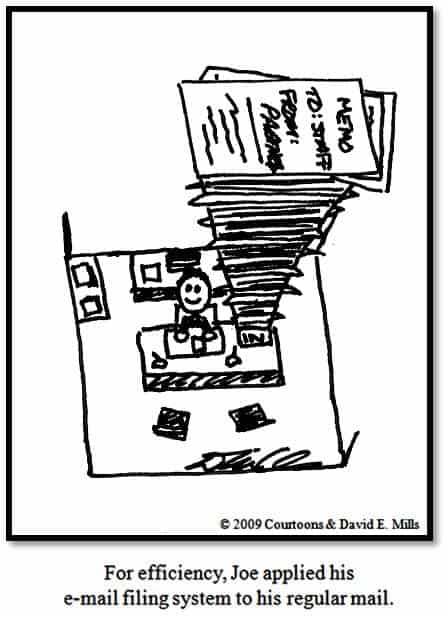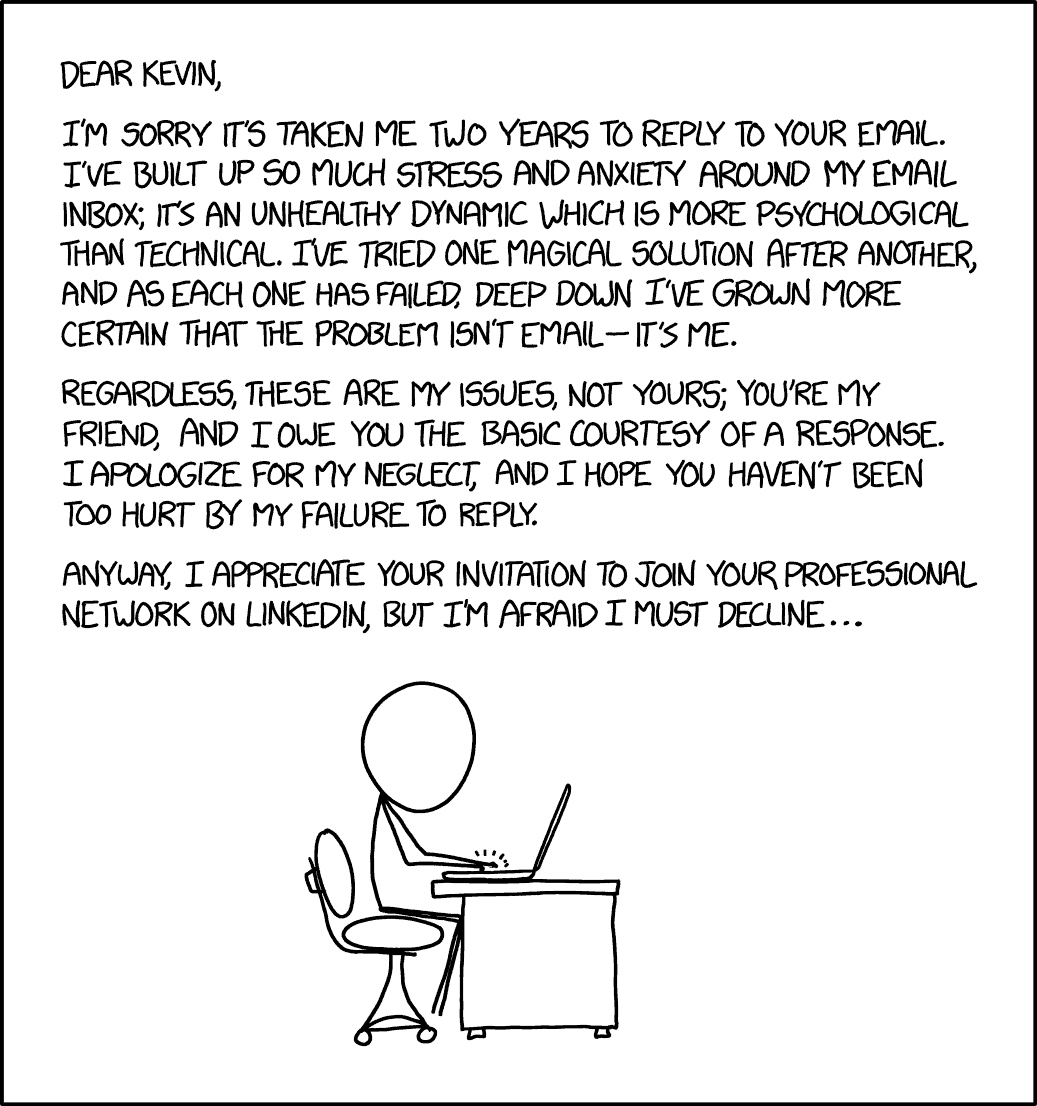Keeping up with internal and external communication is one of the biggest feats of a small business owner. Correspondence can be taxing on your time and draining of your energy. If you’re receiving too many phone calls, an answering service is an easy solution. But how do you reign in too many emails? How do you conquer your inbox?
Remember what an inbox is!
Lets have a flashback sequence.
Remember a when an in-box was an actual box? Or a basket? Or a tray? If you’re a millennial, you may only have a brief memories of when inbox meant something other than email.
They looked a little like this one, from Etsy:
Inbox use went like this:
Someone may stop by at your desk throughout the day and place something on top of the pile of work that was already existing. You’d acknowledge their presence, then carry on with the work you had already committed yourself to. It was only when you had completed your current task, or at the beginning of the day, that you would sort through your inbox. You’d go through the information and decide what needed to be acted upon based on urgency.
You wouldn’t immediately grab it out of the person’s hand, wipe your desk of your current work, and begin working on whatever it was that was coming in. Could you imagine ever getting anything done that way?
It seems like a weird reaction.
But that’s exactly what you’re doing when you’re heading to your email incessantly throughout the day. Or your’e looking at them, then letting them pile up.
An inbox like that would leave you with a pretty cluttered workspace.
Did you know?
The average person checks their email fifteen times during the day. I think it’s safe to say that most small business owners feel like they’re handcuffed to their email inbox.
That’s why our first piece of advice is to…
Treat your Email Inbox Like we did the Inboxes of Yore.
Check it at the beginning of the day, sort through what is most urgent, and then begin acting on items in order of importance. Don’t be a slave to notifications! In fact, we recommend turning email notifications off entirely, and only taking care of emails in batches. That’s a big deal for email productivity. Check your inbox when you’ve come to a stopping point, because most recent request is not the most important one!
But, if you wait too long, the emails will pile up. Right? This may give you something we call…
Email Inbox Anxiety
For some small business owners, the thought of going through and filing all of your emails appropriately, answering to and trashing the rest can sound really daunting.
When it comes to those daunting tasks that seem overwhelming but aren’t time dependent, you know what the average person does? They procrastinate it.
Procrastinating seems impossible for those of us who feel like we receive way too much email. But, here’s the thing:
You don’t receive too much email.
Assuming you haven’t given your email address to every single retailer that’s casually asked for the information at the register (Are we the only ones that think this is PRESUMPTUOUS?), you don’t get too much email. Volume isn’t as big of a problem that you make it out to be. You just receive more email than your current organizational processes can handle. It’s a time management issue. That’s why you’re here.
If you don’t get nervous about all the email piling up, there’s a possibility you have the opposite way of thinking about email.
The other kind of Email Anxiety
There’s an opposing problem that a different personality type of small business owner may have. They just can’t pull themselves away from email. An answer needs to be sent in under an hour. They need to check every notification. They’re worried that if they don’t answer email immediately, they’ll be at fault when the walls around them come crashing in. Every email could be a business opportunity! Everything is urgent!
This has it’s own setbacks. No, you’re not known as “the guy that never responds to emails.” You don’t have to worry about having that reputation. But the issue with the incessant immediate email responder (say THAT ten times fast) is threefold.
- People begin to be dependent on you for answers, and rely less on figuring out solutions on their own.
- You have a work-life balance issue on your hands.
- You are being reactive rather than being proactive.
Proactive vs. Reactive
Being proactive means you’ve put the right strategies and systems in place so that you can appropriately handle your workload without constantly needing a vacation. Whether you’re a procrastinator or an incessant immediate email responder, you don’t have a healthy or efficient way of dealing with your inbox.
But, no worries! The first step is admitting you have a problem. We’ll guide you in getting a better gasp on your email inbox for good.
But first, let’s talk about your outbox.
What’s love Outbox Got to do With it?
You need to start with your own email habits and the way that they are contributing to your email problem.
Do you:
- Send off a quick email when you need help with a problem, then you come across an answer several minutes later that requires you to send a follow-up?
- Think of something shortly after sending an email, so you send another?
- Find yourself bored, sending emails to about little-to-nothing to coworkers or friends, leading to an endless email chain?
- Write emails that are so long that the reader might need a snack or a nap before finishing it?
- Write questions in emails that you find don’t get answered?
- Send “Great, Thanks!” emails?
Then you might need to change the way that you’re treating email.
Our suggestions for a good email outbox:
Pause. Maybe you shouldn’t send that.
Do you really need to send an email to your accountant that you just dropped some stuff off for donations and you’re hoping it’s tax-deductible? Are you about to blow your lid working with family and want to send a quick rant email to your bestie?
Emails aren’t as quick as you think, because they often lead to further conversation. Think about a more appropriate way toward your goal that you think would be achieved through an email. Keep the receipt filed with your other tax documents, and you’ll figure out at tax time the right way to go about things. Make an appointment for lunch or a phone call with your friend so that you can really get off your chest what needs to be said.
Pause before you send, too.
This is in relation to the people who you speak to often. If you’re working directly with someone where several issues could come up throughout the day (or week) that are not time sensitive, start an email and come to it later. There’s a reason the drafts folder exists. Batch up whatever will need to be addressed into a well-formatted email, and send it all at once.
There’s a magic that occurs when you start doing this. Say you send a lot of emails to one of your managers, but decide to follow this technique and start batching all of the issues into an email every Monday morning. You keep the email in drafts, and when you go to add something on Friday, you realize that a solution came up for that question you wrote on Tuesday. You’ll have less issues that need to be addressed, come off as a more competent business leader, and your team can work on tasks that’ll add more revenue to your business.
Format is important.
There’s a lot of things about email etiquette that may not come naturally. That’s why we wrote that post, to get everything clear in those regards. But, what few people use frequently enough is the formatting tool within your email interface.
If you’re sending a message with multiple topics or questions, or if you just want to make sure the message you’re sending is very clear, you can break down items with headers. The recipient is likely to respond in the same, easy-to-read format. For multiple questions, use bullet points or a sequenced list. The recipient, again, is more likely to follow your formatting lead. This leads to far more efficient email reading and answering, and will significantly decrease the amount of time you spend dealing with your inbox.
If you have an important question, ask it at the beginning of the email. It’s more likely to be answered that way.
Make expectations clear.
Sometimes you need information from your recipient before you can move ahead with another task. Don’t be afraid to put a time on a response in these situations. Something like, “Please let me know by 5 p.m. today” or “I’ll need a response by end of business Friday” is perfectly appropriate to say. It may feel pushy at first, but you’ll see that people will know exactly how urgent your email is and will be motivated to meet the deadline per your request.
Why are all of these steps so important?
Raising your standards for how many emails you send and the quality of them will set the bar for others. We hope. Either way, you’ll be apart of the solution, rather than the problem.
Filter Through, Then Act on Emails
Now that you’ve learned to set the tone for your email inbox through the appropriate use of your email outbox, you’ll need to set up a strategy for dealing with the emails you do receive. The system is one of filtering and processing. Have these tasks be separate. It takes the pressure off.
Filtering
During the filtering process, think of yourself as a mail clerk, filing the emails appropriately. You’re deciding what you’re going to do with the emails during the action phase, and no more.
-
- Time this activity. Decide on a set amount of time that you’re going to commit to this activity, and do not go over. Thirty minutes is a good time frame. Don’t worry about every single email if you can’t filter it within the time period, you’ll just go through those during the next block.
- When you’re filtering emails, you’ll decide if each should be acted upon now, acted upon during the next phase, deleted/archived, or delegated to one of your staff members.
- Quick Response: You know what to do right away with these. These are the emails that you’ll spend less time answering quickly than you’d spend filing them for later.
- Defer: Those that you’ve chosen to act upon later are deferred to the processing phase. These are emails that take a long time to read, multiple emails you’ve received from the same person over a relatively short period of time, or actionable requests that will take a significant amount of time. With these emails, you’ll want to flag them. Gmail and Outlook both have ways to categorize your emails. We suggest that you categorize them in the following way:
- Urgent and important
- Not urgent but important
- Urgent but not important
- Not urgent and not important
- You can sort the emails by color based on these categories,
and that way you’re dealing with the most pertinent information, not whatt’s at the top of your inbox. You’ll want to mark these as unread. - Delete:Information read and absorbed.
No further action is needed to be taken. Pretty cut and dry. - Delegate: Forward this message to the right person, then follow up with them later to make sure that it was dealt with in a timely manner. It’s not always easy to remember to followup with someone, that’s why we love the service that Pubs Abayasiri suggests: Followupthen.
Processing
Now that everything is categorized, you start from most important and urgent and follow through to not important and not urgent. We encourage you to make this a scheduled and timed activity, to make sure you stay committed to going through everything.
You know those emails you filtered because there were many from the same person? Write back, answering all of their questions in a well-formatted email. Keep this up, and the person may eventually catch on. Either way, you’re sending less emails and receiving less responses this way.
What about those novel-length emails?
Few people are excited to see big blocks of text when they open an email. Brevity is, of course, preferred.
People write emails like this for one of two reasons:
- This is a stream of thought and they’re using you as a sounding board.
- There is a lot of information they want to share with you, and they think that email is the most time-considerate way to do so.
Either way, they’re not thinking about the amount of time you’ll spend on responding. It’s an honest mistake from the sender. They don’t realize that reading a long email is the least of your worries. The hard part is going through and separating the wheat from the chaff, or the unneeded versus the needed, and then addressing every single one of the issues that they have.
What we suggest is to instead, go through and find all of the topics covered. Let them know you’re really interested in speaking about each topic (list them out, so they’ll feel heard) and you think it’d be better to schedule a call or meeting to discuss A, B, C and D (and E, F, G, H, I). Give the recipient several time slots that work for you, so there will not be a continuous back-and-forth deciding on a time for an in-person or over-the-phone meeting. That’d be a whole new set of unnecessary emails!
Apply this to your small business
An email inbox can be the most dreaded place for a small business owner. The influx of emails can be never ending. Some get overwhelmed by email and avoid it, while others obsessively and compulsively check their email all throughout the day in an inefficient manner. But there’s a better way.
Now, try this…
- Stop checking email incessantly. Schedule when you’ll go through emails instead.
- Send efficient emails. Batch ideas and questions up over a brief time, rather than sending several emails to the same person.
- Utilize formatting that will highlight the important information, categories, or questions that must be answered.
- Use the filter and process technique so that you won’t spend too much time on a single email.











